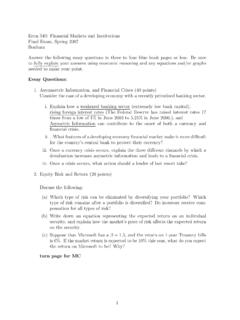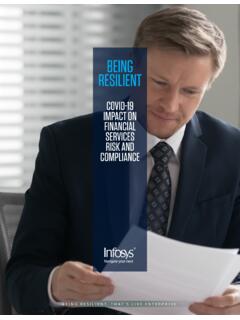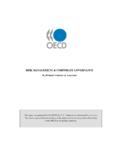Transcription of Managing Uncertainty - The Economist
1 Managing UncertaintyStrategies for surviving and thriving in turbulent timesMichel syrett and Marion Devine Managing 320/08/2012 14:51 THE Economist IN ASSOCIATION WITH PROFILE BOOKS LTDP ublished by Profile Books Ltd 3a Exmouth HousePine StreetLondon ec1r The Economist Newspaper Ltd, 2012 Text copyright Michel Syrett and Marion Devine, 2012 All rights reserved. Without limiting the rights under copyright reserved above, no part of this publication may be reproduced, stored in or introduced into a retrieval system, or transmitted, in any form or by any means (electronic, mechanical, photocopying, recording or otherwise), without the prior written permission of both the copyright owner and the publisher of this greatest care has been taken in compiling this book.
2 However, no responsibility can be accepted by the publishers or compilers for the accuracy of the information presented. Where opinion is expressed it is that of the authors and does not necessarily coincide with the editorial views of The Economist every effort has been made to contact copyright-holders of material produced or cited in this book, in the case of those it has not been possible to contact successfully, the author and publishers will be glad to make amendments in further in EcoType by MacGuru Ltd in Great Britain by Clays, Bungay, SuffolkA CIP catalogue record for this book is available from the British Library Hardback ISBN.
3 978 1 84668 488 3 Paperback ISBN: 978 1 84668 590 3E-book ISBN: 978 1 84765 812 8 The paper this book is printed on is certified by the 1996 Forest Stewardship Council (FSC). It is ancient-forest friendly. The printer holds FSC chain of custody SGS-COC-2061 SGS-COC-2061 Managing 420/08/2012 14:51 Acknowledgements xi Preface xiii1 introduction: Managing in an uncertain world 1 The uncertain world order 2 Speed and multiplication 4 Convergence and interconnectivity 5 Looking ahead 7 New patterns of Uncertainty 11 The essence of this book 132 strategic anticipation 16 Flexible planning 21 Integrating strategy determination and execution 34 Case examples.
4 Capital One Bank, GlaxoSmithKline, Procter & Gamble, RBS, Singapore government, Tata Group 3 navigational leadership 41 Inspiring confidence 46 Ensuring transparency, accountability and good governance 50 Ensuring speedy and informed decision-making 56 Involving and engaging staff 62 Conclusion 66 Case examples: Balfour Beatty, Capital One Bank, Cochrane Collaboration, Ford Motor Company, Honda Europe, HSBC Rail (UK), Marsh, Nokia, Random House, RBS, Simmons & Simmons, States of Jersey, SunGard India, Wipro Infocrossing ContentsManaging 720/08/2012 14:514 agility 68 New rules 69 Competing through agility 71 financial agility 74 Operational agility 81 Portfolio agility 86 Organisational agility 89 Conclusion 95 Case examples.
5 Balfour Beatty, Cisco Systems, GlaxoSmithKline, Netflix Random House, RBS, Simmons & Simmons 5 resilience 96 Developing more resilient managers and businesses 100 Developing resilience in managers 104 Developing a more resilient organisation 113 Provide stability through a sense of shared identity 118 Conclusion 119 Case examples: Ceridian, Ford Motor Company, GlaxoSmithKline, Honda Europe, Lloyds TSB, Random House, Royal Dutch Shell, Simmons & Simmons, States of Jersey 6 open collaboration 121 Internal collaboration 126 Business-to-business collaboration 131 Collaboration with customers 139 Cross-industry or system-wide collaboration 143 Open collaboration: an emergent capability 145 GlaxoSmithKline s strategy of externalisation 147 Case examples.
6 Best Buy, Burberry, Diageo, GlaxoSmithKline, Ford, Gore, HCL Technologies, Marsh, Random House, Wipro Infocrossing 7 Predictive learning 151 Analytics 153 Data mining and categorisation 157 Double-loop learning 160 Managing 820/08/2012 14:51 Abduction 162 Adopting an integrated approach: Cisco Systems and IBM 166 Case examples: Ceridian, Cisco Systems, Deutsche Bank, IBM, Walmart 8 conclusion: creating an integrated approach 170 Reconfiguring businesses to manage Uncertainty 172 Developing a capabilities framework 175 Plotting a pathway 177 Conclusion 183 Appendix 184 Notes 198 Index 202 Managing 920/08/2012 14.
7 51 PrefaceWhen In 2009 we first thought of writing a book on Managing Uncertainty , it was through intellectual curiosity about what our research would wealth of work on the topic had been published in the previous decade, but as much of it was written by academics, it was theoretical and not based on commercial good practice. Much of it was dated and nothing had been written since the global financial crisis that unleashed a new era of Uncertainty for organisations to cope initial instinct that the 2008 crisis was out of the ordinary proved correct.
8 When it occurred, many senior executives assumed that it was another turn in the boom-and-bust cycle that had characterised macroeconomics in developed economies since the end of the second world war. They reacted accordingly, cutting costs and hunkering down for what they supposed would be a painful but short period of , the crisis has ushered in a period of unprecedented Uncertainty , with the economic unknowns augmented by political and social unknowns arising from such developments as the Arab spring and the anti-capitalist and anti-austerity protests in a number of developed is here to stay.
9 Not for nothing did a secretary-general of the United Nations recently comment that the first years of the 21st century may well prove a decisive moment in the human story , requiring co-operation by politicians and business leaders across all boundaries to respond to the interconnected threats the world currently faces (see Chapter 1).A book that examined the implications of Managing Uncertainty Managing 1320/08/2012 14:51xiv Managing uncertaIntyin more practical terms seemed overdue when this book was first commissioned.
10 By the time it was written the case was wanted to use the research to explore three questions. First, how do business people define Uncertainty ? because precise definitions lead to concrete solutions. Second, is Managing Uncertainty becoming a defined management discipline like change or talent management? Third, what are the implications, not just for strategy determination (the focus of most of the early work on the topic) but for an organisation s overall development and culture?The feedback gleaned from senior executives interviewed for the book suggests that, in their eyes, there is no precise definition of Uncertainty and therefore no precise solution.







